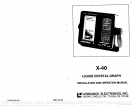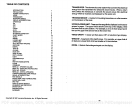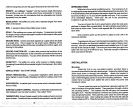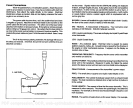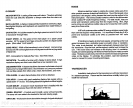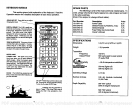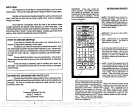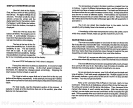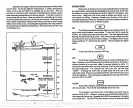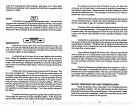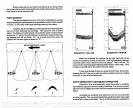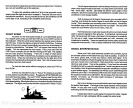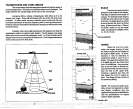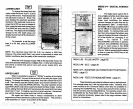
DISPLAY
INTERPRETATION
Now let's look at the
display.
First,
we'll turn on the X-40
by pressing
the
ON
key.
The
lights
will
flash for six
seconds. The chart scrolls the
return
echoes across the screen
and the
digital
searches for the bottom
depth.
It's flashes 0 untIl it finds the
bottom.
Once it finds the
bottom, the
depth
is
displayed.
Here the X-40 has
found the
bottom at
48 feet. The
range
is zero
to
80
feet.
It
automatically
chooses
a
lower limit
that
placesthe
bottom
sig-
nal near
the bottom of the
display.
The bar at the
top
of the dis-
play
is
the
sensitivity
bar. It shows
the
sensitivity
in
use. The bar
extends
from left
to
right.
A
very
short bar
indicates minimum
sensitivity. Setting
__________________
the
sensitivity
to maximum
causes the
bar to run
completely
across
the
top
of the
display.
The word STOP indicates
the X-40's chart is
stopped.
Thetopline
ofthe
chart
isalways
adashed line. It
movesfrom
right
to
left,
showing
the chart is
moving.
As the chart
speed
increases or
decreases,
the dashed
line
changes speed
accordingly. Stopping
the
chart causes the
line to flash on and off.
The
range
is both an
upper
limit and a lower limit
at the
top
and
bottom of the
display,
respectively.
In this
example,
the
range
isO -80 feet.
Scale
markersprinted
on both sidesof
thedisplay
helpdeterminetheactual
depth.
For best
results,
read the
Operation
section of this manual. It
explains
in
detail all of the functions that are in
this
section,
pIus
other
features not
discussed here.
The
temperature
of water in the lake is seldom constant from
top
to bottom.
Layers
of different
temperatures
form,
and the
lunction
of a
warm and cool
layer
of water is a
thermocline. The
depth
and thickness of
thethermoclinecanvarywiththe
season ortime of
day.
In
deep
lakesthere
may
be two or more at different
depths.
Thermoclines are
important
to
fishermen because
they
are areas where
fish are active.
Many
times bait
fish will
be above the thermocline
while
larger
game
fish will
suspend
in or
just
below it.
The X-40 can detect this
invisible
layer
in the
water,
but the
sensitivity
will
probably
have to be turned
up
to
see
it.
A
knowledge
of the water
temperatures
various fish
prefer,
and in
which
they usually
remain,
helps you get
the most from
your
X-40.
SURVEYING A LAKE
The most
successful
anglers
on
any body
of water are
those who
fish it
day
after
day
and
year
afteryear. Eventually, they
learn
the hot
spots
that
produce
fish
consistently. They
discover
through experience where,
and at what
depth, they
can
expect
to find the fish
they
want at
any
season.
And
they
realize that
these
productive
areas
change throughout
the
year
depending
on water
level,
temperature,
food,
and other factors.
With the
X-40, anyone
can
eliminate
guesswork
and
concentrate
on the areas where fish are
likely
to be. Even if ft's the first time on the lake!
The most efficient
wayto
become
acquainted
with
a
body
of water
is to
survey
it with
your
X-40. Start with a
map
of the
lake,
if
possible,
and
indicate the
promising
spots
in relation to landmarks on
shore.
As
you go
about
your survey, your
X-40 will tell
you
the
depth
and
type
of bottom. It will also
reveal
suspended
fish.
Multiple
signals
on the
dial
usually
indicate a
good
school of fish and it's worth it to
stop
and fish
for them. You
may
not
get
any
further.
Keep
a few
Lowrance Fish-N-Floats in the
boat,
ready
to toss
overboard.
When the X-40 indicates a school of
fish,
throw the
buoy
out.
The
string
will
unwind until the sinker hits bottom.
Then,
because of the
marker's flat
shape,
it won't unwind
any
further. With
the school thus
marked, you
can make
your
turn and come
back to fish in
exactlythe right
spot.
This is
essential when
you'refarfrom
shore on
a
big
lake. Unless
you
mark the
school of fish when
you're
over
it, you
may
not be able to find it
again.
6
31
TiTjIii
ii
-L
PDF compression, OCR, web-optimization with CVISION's PdfCompressor



